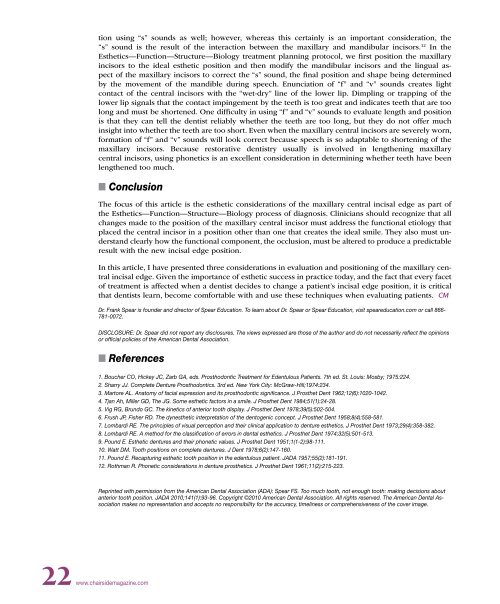PDF Version - Glidewell Dental Labs
PDF Version - Glidewell Dental Labs
PDF Version - Glidewell Dental Labs
You also want an ePaper? Increase the reach of your titles
YUMPU automatically turns print PDFs into web optimized ePapers that Google loves.
tion using “s” sounds as well; however, whereas this certainly is an important consideration, the<br />
“s” sound is the result of the interaction between the maxillary and mandibular incisors. 12 In the<br />
Esthetics—Function—Structure—Biology treatment planning protocol, we first position the maxillary<br />
incisors to the ideal esthetic position and then modify the mandibular incisors and the lingual aspect<br />
of the maxillary incisors to correct the “s” sound, the final position and shape being determined<br />
by the movement of the mandible during speech. Enunciation of “f” and “v” sounds creates light<br />
contact of the central incisors with the “wet-dry” line of the lower lip. Dimpling or trapping of the<br />
lower lip signals that the contact impingement by the teeth is too great and indicates teeth that are too<br />
long and must be shortened. One difficulty in using “f” and “v” sounds to evaluate length and position<br />
is that they can tell the dentist reliably whether the teeth are too long, but they do not offer much<br />
insight into whether the teeth are too short. Even when the maxillary central incisors are severely worn,<br />
formation of “f” and “v” sounds will look correct because speech is so adaptable to shortening of the<br />
maxillary incisors. Because restorative dentistry usually is involved in lengthening maxillary<br />
central incisors, using phonetics is an excellent consideration in determining whether teeth have been<br />
lengthened too much.<br />
■ Conclusion<br />
The focus of this article is the esthetic considerations of the maxillary central incisal edge as part of<br />
the Esthetics—Function—Structure—Biology process of diagnosis. Clinicians should recognize that all<br />
changes made to the position of the maxillary central incisor must address the functional etiology that<br />
placed the central incisor in a position other than one that creates the ideal smile. They also must understand<br />
clearly how the functional component, the occlusion, must be altered to produce a predictable<br />
result with the new incisal edge position.<br />
In this article, I have presented three considerations in evaluation and positioning of the maxillary central<br />
incisal edge. Given the importance of esthetic success in practice today, and the fact that every facet<br />
of treatment is affected when a dentist decides to change a patient’s incisal edge position, it is critical<br />
that dentists learn, become comfortable with and use these techniques when evaluating patients. CM<br />
Dr. Frank Spear is founder and director of Spear Education. To learn about Dr. Spear or Spear Education, visit speareducation.com or call 866-<br />
781-0072.<br />
DISCLOSURE: Dr. Spear did not report any disclosures. The views expressed are those of the author and do not necessarily reflect the opinions<br />
or official policies of the American <strong>Dental</strong> Association.<br />
■ References<br />
1. Boucher CO, Hickey JC, Zarb GA, eds. Prosthodontic Treatment for Edentulous Patients. 7th ed. St. Louis: Mosby; 1975:224.<br />
2. Sharry JJ. Complete Denture Prosthodontics. 3rd ed. New York City: McGraw-Hill;1974:234.<br />
3. Martore AL. Anatomy of facial expression and its prosthodontic significance. J Prosthet Dent 1962;12(6):1020-1042.<br />
4. Tjan Ah, Miller GD, The JG. Some esthetic factors in a smile. J Prosthet Dent 1984;51(1):24-28.<br />
5. Vig RG, Brundo GC. The kinetics of anterior tooth display. J Prosthet Dent 1978;39(5):502-504.<br />
6. Frush JP, Fisher RD. The dynesthetic interpretation of the dentogenic concept. J Prosthet Dent 1958;8(4):558-581.<br />
7. Lombardi RE. The principles of visual perception and their clinical application to denture esthetics. J Prosthet Dent 1973;29(4):358-382.<br />
8. Lombardi RE. A method for the classification of errors in dental esthetics. J Prosthet Dent 1974;32(5):501-513.<br />
9. Pound E. Esthetic dentures and their phonetic values. J Prosthet Dent 1951;1(1-2):98-111.<br />
10. Watt DM. Tooth positions on complete dentures. J Dent 1978;6(2):147-160.<br />
11. Pound E. Recapturing esthetic tooth position in the edentulous patient. JADA 1957;55(2):181-191.<br />
12. Rothman R. Phonetic considerations in denture prosthetics. J Prosthet Dent 1961;11(2):215-223.<br />
Reprinted with permission from the American <strong>Dental</strong> Association (ADA): Spear FS. Too much tooth, not enough tooth: making decisions about<br />
anterior tooth position. JADA 2010;141(1):93-96. Copyright ©2010 American <strong>Dental</strong> Association. All rights reserved. The American <strong>Dental</strong> Association<br />
makes no representation and accepts no responsibility for the accuracy, timeliness or comprehensiveness of the cover image.<br />
22 www.chairsidemagazine.com

















